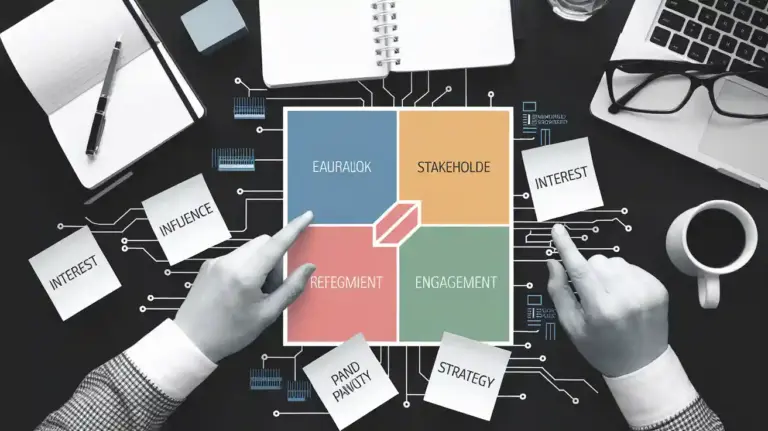You want to make a difference in your organization, but you don’t have the authority to make changes on your own. You may feel like you’re stuck and unable to influence the direction of your team or company. However, there is an art to influencing change without authority.
It involves building relationships, understanding motivations, creating a compelling case for change, overcoming objections, and implementing and sustaining change.
In today’s fast-paced business world, the ability to influence change without authority is essential for success. By mastering this art, you can become a valuable member of any team, regardless of your position. You can help your organization move forward and achieve its goals, while also advancing your own career.
So, are you ready to learn the art of influencing change without authority? Let’s get started!
Building Relationships for Effective Communication
Establishing strong connections is fundamental to facilitating productive communication. As someone who wants to influence change without authority, building relationships can help you get your message across.
Active listening is an important skill to develop when building relationships. It is crucial to pay attention to what others are saying, show empathy, and respond appropriately.
In addition to active listening, having emotional intelligence is also critical in building relationships. It involves being aware of your emotions, understanding the emotions of others, and using that knowledge to guide your interactions. Emotional intelligence can help you connect with others on a deeper level and build trust. By being aware of your own emotions, you can also regulate them to avoid reacting impulsively in a way that could damage the relationship.
When you invest time and effort in building relationships, it can pay off in many ways. You can gain valuable insights, get buy-in for your ideas, and build a network of supporters. By actively listening and using emotional intelligence, you can establish trust and understanding with others. This can create a positive environment for communication and help you influence change without authority.
Understanding Motivations and Needs
Understanding people’s motivations and needs is key to effectively driving progress and achieving results. This requires empathy and an understanding of psychology, as well as an ability to analyze power dynamics. By recognizing what drives others and what they need to succeed, you can better communicate your ideas and influence change without relying on formal authority.
Empathy is crucial in understanding motivations and needs. Take the time to put yourself in someone else’s shoes and consider their perspective. What are their goals? What are their fears? By understanding these factors, you can tailor your communication to resonate with them and build a stronger connection. This can help you to gain their trust and influence their actions.
Analyzing power dynamics is also important in understanding motivations and needs. Take note of who holds power in a given situation and how that power is distributed. By recognizing who has the most influence and what their motivations are, you can better navigate the situation and work towards your own goals. This can involve building alliances with those who hold power, or finding ways to appeal to their motivations in order to gain their support.
Remember, understanding people’s motivations and needs is key to effectively driving progress and achieving results. By approaching situations with empathy and an understanding of psychology, as well as analyzing power dynamics, you can build stronger relationships and influence change without relying on formal authority.
Creating a Compelling Case for Change
You can create a powerful argument for transformation by showcasing the benefits that come with embracing new ideas and ways of doing things. Crafting narratives that highlight the positive outcomes of change can be a compelling way to persuade others to support your vision. A well-crafted story can help people see the potential benefits of change and inspire them to take action.
When crafting your narrative, it’s important to use persuasive messaging that speaks directly to your audience’s needs and motivations. Understanding what drives them and what they value can help you tailor your message to resonate with them on a deeper level.
For example, if your audience is motivated by financial gains, you can highlight how the proposed change can save the company money or increase revenue. If they value work-life balance, you can show how the change can improve their quality of life.
Ultimately, creating a compelling case for change requires a combination of storytelling and persuasive messaging. By showcasing the benefits of your proposed changes and crafting a narrative that speaks to your audience’s needs and motivations, you can inspire others to support your vision and take action towards achieving it.
Remember, the power of your message lies not only in its content but in how effectively you communicate it to others.
Overcoming Resistance and Objections
If you’re facing pushback on your proposed changes, don’t worry – it’s normal, and there are ways to overcome it. In fact, according to a recent study, 85% of change initiatives encounter resistance at some point.
To overcome resistance, you need to identify the root causes. Is it fear of the unknown? Lack of trust in the leadership? Or maybe a perceived threat to someone’s status quo? Once you identify the underlying causes, you can address them directly and effectively.
One of the most effective negotiation tactics for overcoming resistance is to focus on the benefits of the change, rather than the process itself. People are more likely to accept change when they see how it will benefit them personally. So, instead of talking about the technical details of the change, focus on how it will improve their work, make their jobs easier, or help them achieve their goals. Be specific and concrete, and use examples that are relevant to their situation.
Another effective tactic is to involve the resistors in the change process. People are more likely to support a change if they feel like they have a say in it. Ask for their input and feedback, and incorporate their ideas into the plan. This will not only address their concerns, but also make them feel valued and respected.
By involving resistors in the change process, you can turn them into allies and champions of the change.
Implementing and Sustaining Change
Let’s dive into how to make change stick and build a culture that embraces it. As you know, implementing and sustaining change can be challenging, but it’s essential for progress and growth.
To ensure changes are successful, you need to identify and nurture change champions within your organization. These individuals are passionate about continuous improvement and can help you inspire others to embrace change.
To build a culture that embraces change, you need to create a sense of ownership and accountability. Here are three sub-lists to help you achieve this goal:
- Clearly communicate your vision and explain why the change is necessary. You need to paint a picture of the future and the benefits of the change. People need to understand why they should care about the change and what’s in it for them.
- Involve people in the process. When people are involved in the change process, they feel more invested and are more likely to embrace the change. You can involve people by seeking their input, creating cross-functional teams, and empowering them to make decisions.
- Celebrate wins and recognize progress. Change can be difficult, and it’s essential to celebrate successes along the way. Recognize individuals and teams that have contributed to the change, and use their success stories to inspire others.
In conclusion, implementing and sustaining change is critical for progress and growth. To make change stick, you need to identify change champions and build a culture that embraces continuous improvement. By creating a sense of ownership and accountability, involving people, and celebrating wins, you can inspire others to embrace change and build a better future for your organization.
How Can Leveraging Data Help in Influencing Change without Authority?
Leveraging data for change can be a powerful tool in influencing decision-makers, even without formal authority. By presenting compelling data-driven insights, it becomes easier to sway opinions and guide strategic shifts. Solid data can help build a persuasive case for change and drive impactful results within an organization.
Conclusion
So, you want to be a change agent but don’t have the authority? Don’t worry, you can still make a difference.
The art of influencing change without authority requires building relationships, understanding motivations, creating a compelling case for change, and overcoming resistance and objections.
Think of yourself as a gardener. You plant the seed, nurture it, and watch it grow. It takes time and patience, but with consistent effort, you can transform a barren land into a beautiful garden. Similarly, you can influence change by planting the seed of an idea, nurturing it with effective communication and relationship building, and watching it grow into a successful change initiative.
Remember, change is not easy, but it’s necessary. According to a study by McKinsey, 70% of change initiatives fail due to lack of employee engagement and resistance to change. By adopting the art of influencing change without authority, you can increase employee engagement, reduce resistance, and achieve successful change.
So, start planting those seeds and watch your garden bloom.





